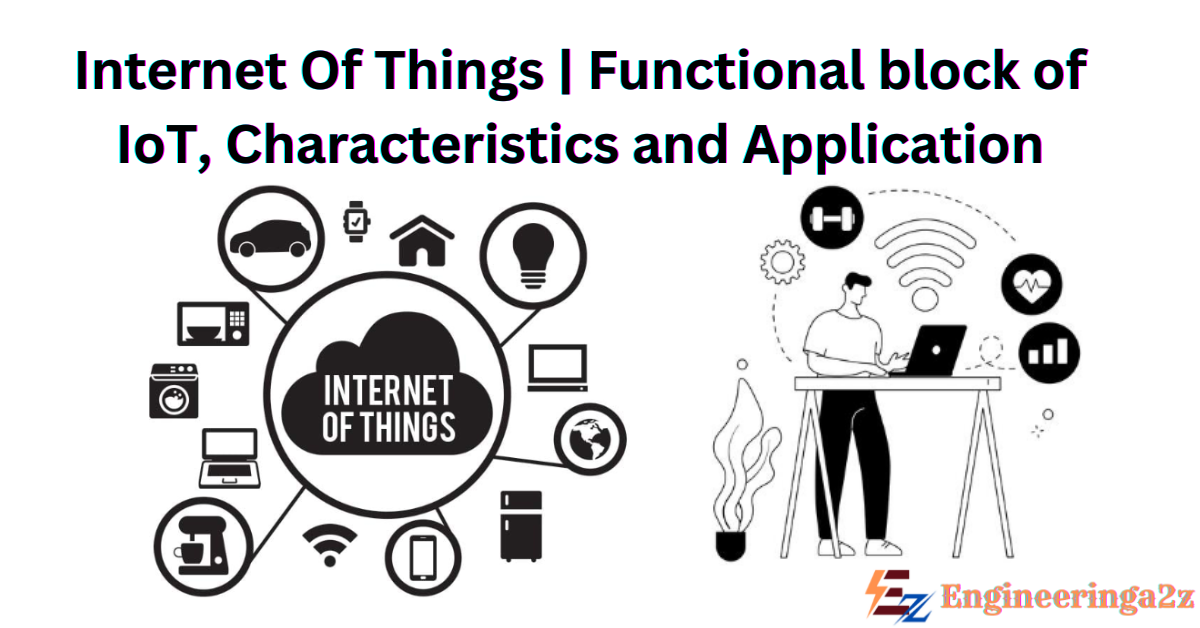
Table of Contents
Internet of Things
Internet of Things (IoT) means connecting everyday objects to the internet using electronics, software, and sensors. This allows them to collect and share data, making it possible for these devices to work together, monitor things in real-time, and automate tasks.
Functional Block of IoT
The functional block of IoT are responsible for sensor, processors, Gateways and application.

- Sensor: These form the front end of the IoT devices. These are the so called “Things” of the system. Their main purpose to collect data from it’s surrounding- sensors or give out data to its surrounding- actuators. Examples:- Gas sensor, water quality sensor, moisture sensor etc.
- Processors: Processors are the brain of the IoT system. Their main function is to process the data captured by the sensors and process them so as to extract the valuable data from the enormous amount of raw data collected.
- Gateways: Gateways are responsible for routing the processed data and send it to proper locations for its proper utilization. Examples:- LAN, WAN, PAN etc.
- Application: Application form another end of an IoT system. Application are essential for proper utilization of all the data collected. Application are controlled by users and are a delivery point of particular service. Examples:- Home automation apps, security systems etc.
Characteristics of IoT
There are 7 crucial IoT characteristics:

The most important characteristics of IoT on which it works are connectivity, intelligence, Enormous scale, Heterogeneity and many more. Some of them are listed below:
1.Connectivity: Iot means anything, anywhere, anytime should be connected to the infrastructure without connection nothing makes sense.
2.Intelligence: Extraction of knowledge from the general data is important sensor generate data and this data should be interpreted properly.
3. Enormous scale: The number of devices that needs to be managed and that communicate with each other will be must larger the devices connected to the internet.
4. Heterogeneity: Devices in IoT are based on different hardware platform and network can interact with other devices or services platform through different networks.
5. Unique Identity: Each IoT devices has an own IP address. This is very helpful to tracking the equipment and at time to query for its status.
6. Dynamic and self adapting: The IoT devices must dynamically adopt itself to changing context like temperature, location, speed etc.
7. Safety: It’s include safety of our personal data and the safety of our physical well being.
How IoT Work
- Data collection: Its sensor in IoT devices collect data from their surrounding area.
- Data transmission: The collected data is sent to a central system or cloud internet.
- Data Processing: The central system processes the data to drive useful information.
- Action: Its based on the processed data an action is taken. Example:- Smart thermostat based on the weather forecast or condition.
Advantages of IoT
Some of benefits are given below:
- Its save lots of time and efforts.
- Its improve our security system.
- Its very useful for safety concern.
- Its useful in the healthcare industry.
- Enhanced data collection.
Disadvantages of IoT
Some of IoT challenges are given below:
- Its Security Issues.
- Privacy concern.
- Its increased very high unemployment rates.
- Its very highly depends on the internet.
- Its reduced mental and physical activity.
Application of IoT
Some of application are given below:
- Smart home and building automotive: Devices like smart light, thermostat and security system make home and building more convenient and energy-efficient.
- Healthcare: The connected devices like monitor patients health condition in real time, improve care and all time remote enabling.
- Industrial Automation: Factories use connected machinery to monitor performance and increasing efficiency.
- Smart cities: IoT technologies manage traffic reduced energy consumption and enhance public safety.
- Remote monitoring etc.
Frequently Asked Questions (FAQs)
What is a IoT?
Internet of Things means connecting everyday thing embedded with electronics, software and sensors to the internet enabling them to collect and exchange data.
Who invented IoT?
The term ‘Internet of Things‘ was coined in 1999 by the computer scientist Kevin Ashton.
What is the scope of IoT?
IoT allows business and people to be more connected to the world around them, and to do more meaningful, higher level work etc.
How is IoT used in daily life?
We can use Internet of Things in our everyday lives include like Smart appliances (refrigerators, washers and dryers, coffee machine etc.) Smart security systems, Smart locks, and smart doorbells etc.
Related Posts
- Travelling Wave Tube | Construction, Working and Applications
- Radar | Types of Radar, Advantages and Disadvantages
- Radar | Block Diagram, Working Principle and it’s Applications
- Multiple Access Techniques for Wireless Communication
- Internet of Things | Functional Block of IoT, Characteristics and Application
- Microphone | Types, Block Diagram, and its Working












Leave a Reply